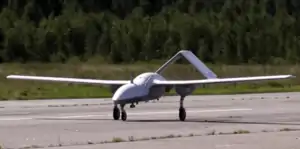Luch Korsar
The Luch Korsar (Russian: Корсар, English: 'Corsair') is a medium-weight Russian unmanned aerial vehicle developed by OKB Luch, member of Roselectronika, to perform reconnaissance, strike and electronic attack missions on behalf of the Russian Ground Forces and Navy.[4] The program started in 2009 and at least 3 prototypes have been built as of 2019.[1] It is considered as an improved analogue of the US-made RQ-7 Shadow UAV.[5]
| Korsar | |
|---|---|
 | |
| The Korsar UAV during take off | |
| Role | Reconnaissance Unmanned aerial vehicle Unmanned combat aerial vehicle Electronic warfare |
| National origin | Russia |
| Manufacturer | OKB Luch |
| Design group | OKB Luch, Roselectronika group |
| First flight | 2015[1] |
| Introduction | 2018[2] |
| Status | In limited service |
| Primary users | Russian Ground Forces |
| Number built | 3[3] |
Development
OKB Luch began working on the Korsar project in 2009 and commenced flight testing in 2015. It was unveiled for the first time at the 2018 Moscow Victory Day Parade on May 9.[6]
At first, the Korsar was considered to be a medium-weight UAV for tactical applications with no mention of its ability to perform kinetic strikes. According to Rostec in May 2018, Korsar serial production is being set up. In the future, this system may come with improved air vehicles whose operational range would be increased from 120 to 160 km (65 to 86 nautical miles) currently to 250 km (135 nm). They will carry mission equipment with enhanced functionality in air reconnaissance and electronic warfare and reconnaissance.[7]
According to Russian Deputy Minister Gen. Yuri Borisov, responsible for weapons procurement, the Russian Minister of Defence will be procuring a large quantities of Korsar.
Design
The Korsar features a twin-boom design with V-tail empennage and a single 50-to-70 hp piston engine driving a twin-blade pushing propeller, similar in design to the US RQ-7 Shadow and the Turkish Bayraktar TB2.
Operational history
Russian sources argue that the Korsar has already been tested in Syria, targeting rebels, various types of armored vehicles and infrastructural objects. It is said that its excellent performance has “persuaded the military to integrate it in the Russian armed forces”.[5]
Variants
- Korsar
- Serial variant.
- Korsar-M
- Seaborn variant for the Russian Navy.[8]
Specifications
General characteristics
- Crew: 0
- Length: 4.2 m (13 ft 9 in)
- Wingspan: 6.5 m (21 ft 4 in)
- Empty weight: 200 kg (441 lb)
- Max takeoff weight: 400 kg (882 lb)
- Payload:
Performance
- Maximum speed: 150 km/h (93 mph, 81 kn)
- Range: 250 km (160 mi, 130 nmi)
- Endurance: 12 hours
- Service ceiling: 2,000 m (6,600 ft)
Armament
- Bombs: Guided and unguided bombs
See also
Related development
Aircraft of comparable role, configuration, and era
References
- Karnozov, Vladimir. "Russia Unveils New Missile-armed UCAVs". Aviation International News.
- http://eng.mil.ru/en/news_page/country/more.htm?id=12174132@egNews
- "Russian Altius-U Unmanned Aerial Vehicle flies for the first time". August 24, 2019.
- "Russia to furnish advanced Korsar drones with electronic warfare systems". TASS.
- "Syrian Experience Provides New Impetus for Russia's UAV Strategy (Part One)". Jamestown.
- "New Korsar UAV to take part in Russia's Victory Day parade for the first time". defence-blog.com. April 25, 2018.
- "Russia's New Korsar Surveillance UAV To Get An Upgrade Of EW Systems". www.defenseworld.net.
- https://www.navyrecognition.com/index.php/news/defence-news/2019/october/7633-russian-korsar-drone-may-get-a-seaborne-option.html
